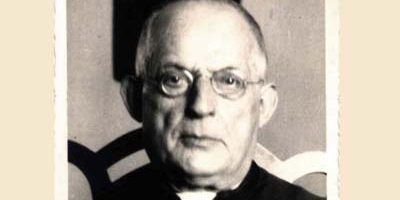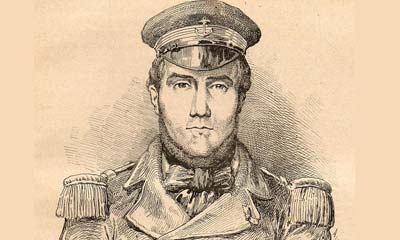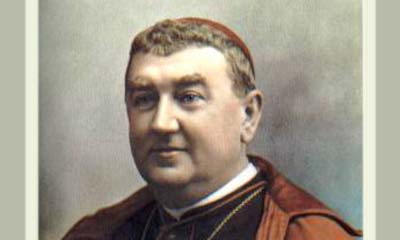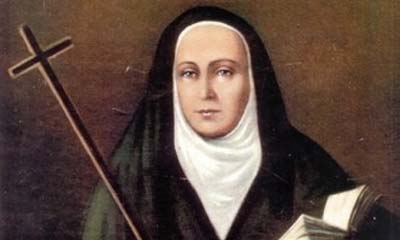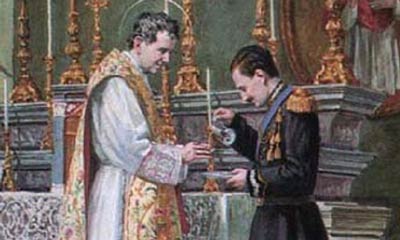April 10, 2024
Saint Filippo Smaldone
Dear Friends,
The year is 1868. A young Neapolitan seminarist is leaving the archiepiscopal palace in a sorry state, having been told by his archbishop that he will not be ordained to the priesthood because of his poor examination marks. Reflecting on this “blow of fate” which has seemingly put an end to the dream of his life, he resolves to become a teacher for abandoned young deaf-mutes. God’s Providence is making use of the young man’s disappointment in order to endow the Church with a new religious family.
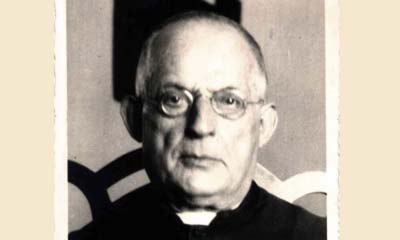 Filippo Smaldone was born in Naples on July 27, 1848, the eldest of the seven children of Antonio and Maria-Concetta, in a modest middle-class family. Antonio owned a building materials store in a densely populated district of Naples. The seven children received a vigorous Catholic upbringing and were encouraged to practice charitable works. Filippo often attended the “Cappella Serotina” of Santa Maria della Purità, where he acquired a taste for the things of God. In 1858, he made his First Holy Communion. The Cappelle Serotine or “Evening Chapels” had been founded in Naples by St Alphonsus Liguori (1696-1787), Doctor of the Church, to provide catechesis and spiritual formation for the common people. There were seventy of them in Filippo’s time; at Santa Maria, he had the benefit of a lively and accessible catechism. He also learned to pray the Rosary.
Filippo Smaldone was born in Naples on July 27, 1848, the eldest of the seven children of Antonio and Maria-Concetta, in a modest middle-class family. Antonio owned a building materials store in a densely populated district of Naples. The seven children received a vigorous Catholic upbringing and were encouraged to practice charitable works. Filippo often attended the “Cappella Serotina” of Santa Maria della Purità, where he acquired a taste for the things of God. In 1858, he made his First Holy Communion. The Cappelle Serotine or “Evening Chapels” had been founded in Naples by St Alphonsus Liguori (1696-1787), Doctor of the Church, to provide catechesis and spiritual formation for the common people. There were seventy of them in Filippo’s time; at Santa Maria, he had the benefit of a lively and accessible catechism. He also learned to pray the Rosary.
Over the last few decades, Italy had been rocked by the Risorgimento movement. Legitimate aspirations to national independence were often combined with animosity towards the Church and the clergy. In 1860, the Condottiere Garibaldi landed in Sicily at the head of a thousand volunteers; from there, he marched on Naples, which he seized through the treachery of Bourbon King Francis II’s troops. The Kingdom of the Two Sicilies was soon annexed by Victor Emmanuel II, the self-proclaimed King of Italy. Because he had voiced his opposition to the coup, Cardinal Riario Sforza, the Archbishop of Naples, was banished by the new authorities, and a hundred influential priests were arrested.
It was in this challenging context that Filippo Smaldone, under the guidance of his confessor, heard in his heart the call of Jesus to follow Him into the priesthood. He was fifteen when, in September 1863, he was admitted to the Neapolitan clergy and received the cassock. He continued to live at home and studied humanities at a diocesan college. Due to the government’s impounding of ecclesiastical property, seminarists could only receive Holy Orders if they had a yearly income. Filippo’s father lacked the resources to provide for his son, but a priest friend pledged to supply the necessary funds. In December 1866, Cardinal Riario Sforza, who had returned from exile, conferred the first two minor orders on the young man:they are the first steps towards the priesthood.
However, this otherwise admirable prelate—in 2012, Benedict XVI issued a decree recognizing his heroic virtues—was very demanding when it came to the intellectual abilities of his seminarists. Having scrutinized Filippo Smaldone’s academic records, the cardinal, while acknowledging his moral qualities, rejected him on the grounds of intellectual inadequacy; other saints have encountered similar difficulties, not least St John Vianney, the Holy Curé of Ars. But in his heart, the young man still felt that God wanted him to be a priest, and his confessor, Don Biagio Giustiniani, encouraged him to look for another bishop who would receive him in his diocese, and recommended him to Pietro Cilento, Archbishop of Rossano in Calabria. The latter sent for Filippo at Christmas in 1868; he was so edified by the young man that he soon declared himself willing to incardinate him, i.e. to incorporate him into his diocesan clergy. In February 1869, he was granted permission to do so by Pope Pius IX.
That same year, Filippo was appointed to teach deaf-mute children. The “Pia Casa” (Pious Home) where he arrived had been founded in Naples on June 21, 1856 by a priest, Don Luigi Aiello. The latter had dreamed of a religious congregation with two branches, male and female, dedicated to the education of deaf-mute children. He was unsuccessful, and in 1862, feeling his strength decline (he died in 1866), Don Aiello entrusted the education of deaf girls to the Stigmatine Sisters. The boys would be taken care of by the “Frati Bigi”, the Franciscans of Casoria; it was in their Neapolitan convent that Filippo Smaldone began to teach catechism under the direction of Don Apicella, Don Aiello’s successor. On completing his ecclesiastical studies, Filippo Smaldone was admitted to the priesthood by Bishop Cilento, following the positive opinion of his spiritual father and of Don Apicella. He was ordained in Naples on September 23, 1871 by a missionary bishop. Bishop Cilento granted the young priest permission to remain in Naples to continue his studies and care for the deaf. Filippo, who was still living in his father’s house, carried out a discreet apostolate in the city. But the work of the “Pia Casa” ran into serious operational difficulties. In 1873, Don Apicella withdrew it from the “Frati Bigi”, who were neglecting it, and transferred it to Santa Maria dei Monti, but this move did little to improve the situation. Don Smaldone was suffering because of it, and in his heart he felt the desire to leave as a missionary for a distant land. The prospect was worrying to his parents: they pointed out to Filippo that the apostolate of the deaf was a genuine missionary work, as these children were totally abandoned, especially from a spiritual point of view. At the time, the Church did not dare to give born-deaf children the sacraments (apart from Baptism), because of their religious ignorance resulting from their handicap. Their eternal salvation was therefore in jeopardy, due to a lack of methodical religious instruction and of the sacramental life.
Special Respect
Under the guidance of the Holy Spirit, the Church has given thought to this problem. The Directory for Catechesis, published on March 23, 2020 by the Pontifical Council for Promoting the New Evangelization, states: “Disabled people are called to the fullness of sacramental life, even in the presence of serious disorders. The sacraments are gifts of God and the liturgy, which even before being understood rationally, ask to be lived: therefore, no one can deny the sacraments to people with disabilities” simply because of their handicap (no. 272). In a similar vein, the Catechism of the Catholic Church teaches: “Those whose lives are diminished or weakened deserve special respect. Sick or handicapped persons should be helped to lead lives as normal as possible” (no. 2276).
Fully appraised of Filippo’s situation and state of mind, his confessor, Don Giustiniani, assured him that his desire to be a missionary indeed came from God, but that the land he was called by God to evangelize was not some distant country: “Your China is here, in Naples; your infidels are the deaf and dumb. God wants you here!” Filippo heeded his advice, and in 1876 moved to Santa Maria dei Monti, where he carried out his apostolate on a full-time basis from then on. Cardinal Riario Sforza was deeply impressed, and soon reintegrated him into the clergy of Naples. In 1880, Don Smaldone was sent to an international congress in Milan on the education of the deaf as an expert. It was there that he developed his oral teaching method, which he perfected over the years. It consisted in gradually teaching deaf people to lip-read and to pronounce the syllables. It has now been supplanted by the more successful sign language method.
A Supplication to the Madonna
In the summer of 1884, a cholera epidemic broke out in Naples. There were over 12,000 cases and 5,500 people died. Following the example of his new archbishop, Cardinal Sanfelice, who went onto the streets in order assist the sick in person, Don Smaldone threw himself wholeheartedly into this apostolate. Together with a group of faithful, he went to the shrine of Pompeii that had recently been opened by a layman, Blessed Bartolo Longo, to beseech Our Lady to help the Neapolitans. Filippo wrote this supplication which was placed before the statue of Mary: “The undersigned, humble and ashamed sinners, have recourse to the Queen of the Rosary of Pompeii, St Mary of the Victory, and beseech her to appease the justice of God that is so offended by their sins, that she may preserve them first of all from the eternal death of hell, and also from this cholera which so terribly afflicts our land. They undertake to bring an offering to this shrine as soon as the epidemic is over, and if none of them dies of it.”
Filippo worked unsparingly alongside the cholera victims. On September 13, he was struck down by the disease, and by the same evening his condition was judged to be beyond hope. A Neapolitan newspaper announced the priest’s death, calling him a “martyr to duty”. Bartolo Longo mourned for him, but later recounted how one day in October, Pasquale Smaldone came to tell him that his brother Filippo was alive. While displaying all the signs of imminent death, he had wrapped his rosary around his wrist, praying the Rosary over and over and invoking the Virgin of Pompeii. The next day, he was out of danger. Bartolo Longo ended his story with these words: “Don Smaldone was saved from the general ‘shipwreck’ by the mystical crown of Mary’s Rosary.” Filippo soon returned to Pompeii to celebrate a Mass of thanksgiving.
Meanwhile, the “Pious Union” founded in 1875 by priests dedicated to the education of the deaf and dumb remained unsuccessful in establishing itself as a stable religious congregation. What was God’s will?, Don Smaldone asked himself. He believed he could discern it in the founding of a congregation of nuns dedicated to the evangelization and education of the deaf. Three young girls were willing to work with him on this project, which he entrusted to Our Lady of the Rosary. A pressing request for the foundation of a home for deaf children had been sent to the Neapolitan organization by dignitaries from Lecce, the main town in the Terra d’Otranto, 250 miles (400 km) east of Naples. In March 1885, Fathers Apicella and Smaldone arrived in Lecce with the three young girls, who had just received the religious habit. They were warmly welcomed by Archbishop Luigi Zola.
Their work got off to a difficult start. Although full of zeal as a priest, Don Apicella was sadly disorganized. He left Lecce after a few months, taking with him the meagre funds raised for the foundation, and leaving Don Smaldone and the three nuns in the lurch. Filippo informed Bishop Zola, who reacted angrily, proclaiming to have been let down and deceived by the founders. As a consequence, the donors from Lecce asked Filippo to refund their donations. Undeterred, he stayed on. In September 1885, a young mother entrusted her ten-month-old baby, Serafina, who was showing symptoms of deafness, to the newly founded organization. Little by little, other inmates were admitted. In October 1887, the mayor of Lecce, after inspecting the home, wrote the following report: “The little girls, now eight in number, sleep in separate beds and are fed and cared for in a truly praiseworthy manner… This institute is very valuable, but the state of its finances does not allow it to receive more than eight boarders; it depends entirely on donations from the citizens of Lecce.” This favorable report won back the sympathy of the inhabitants for Don Smaldone, and they resumed their financial support, to which was added that of the municipality. He could thank Providence, to which he had completely abandoned himself.
Under the Emblem of the Pierced Heart
Filippo did not wish to do anything without Bishop Zola’s assent; the latter reconsidered his initial reservations and now took the growing institute to heart. On March 25, 1886, Don Apicella gave Don Smaldone full authority over the Lecce foundation. The following year, the Archbishop established the institute of the “Salesian Sisters of the Sacred Hearts” (not be confused with Don Bosco’s Salesians) as a pious association under diocesan law, in reference to St Francis de Sales who is revered as the heavenly patron saint of the deaf. For seventeen years, from 1605 until his death, the Bishop of Geneva had placed a young deaf man from his diocese under his protection, patiently instructing and catechizing him himself. He had also chosen as his emblem for the Order of the Visitation a pierced heart surrounded by a crown of thorns, with the initials of Jesus and Mary. Don Smaldone would adopt the same emblem for his religious institute.
In 1895, the Archbishop of Lecce decided that the time had come to establish the Salesian Sisters of the Sacred Hearts as a religious congregation. In his decree, Archbishop Zola took credit for the initiative, appearing as the work’s founder. He seemed to forget that Don Smaldone, who was not even mentioned in the text, was the sole initiator of the project; without his perseverance despite the prelate’s bitter words, the congregation would never have existed. But in his humility, Filippo remained silent. He rejoiced to see the number of nuns increase, and was able to respond to numerous requests for foundations, in particular one in Rome in 1896, which would later become the Generalate. The following year, at the request of the authorities in Bari, Don Smaldone began taking in poor children in that city, who were sick but not necessarily hearing-impaired. After sending Salesian Sisters to Rome and Florence to train in this type of education, he began taking in blind girls in 1900. In 1902, with the help of the new Archbishop of Lecce, he was able to acquire a former Carmelite convent, the “Scalze” (the Discalced), with its beautiful Baroque church.
Fully Booked
In the summer of 1907, the municipality of Lecce, which had fallen into the hands of the Socialists, suspended all financial aid to the Salesian Sisters. These ideologists believed that all educational work should be in the hands of the secular state. Anti-clerical newspapers orchestrated a smear campaign. A municipal commission spent the whole month of August at the “Pia Casa”, carrying out a detailed investigation in the hope of finding grounds for censure; the publication of a malicious report ensued. Although impartial newspapers pointed out the errors and slander contained in this text, Don Smaldone spent those days in anguish. He suffered most from the perfidious accusations against the nuns’ purity and his own priestly honor. Without seeking to justify themselves, he and the Salesian Sisters turned to more insistent prayer. Providence did not fail to help them, sending them enough benefactors to compensate for the withdrawal of their municipal funding. As early as October 1907, Filippo was able to respond to the calumny by opening a college for young girls in Lecce, which was soon fully booked.
The Archbishop of Lecce wanted official papal recognition for the Salesian institute. But after the smear campaign of 1907, the Holy See wished to clarify the situation and appointed an Apostolic Visitor, who visited all the institute’s houses in succession. Don Smaldone gladly subjected the work to such Roman scrutiny. In 1912, the congregation was affiliated to the Franciscan order. In 1915, the Holy See published a “Decree of Praise”, a necessary prelude to the final approval of the Congregation in 1925.
Don Filippo drew his apostolic energy from a profoundly contemplative life; his every decision was matured at length in prayer. His two main devotions were his veneration for the Blessed Sacrament and his love of the Blessed Virgin Mary. His Eucharistic devotion manifested itself in beautifully prepared, splendid religious services that drew crowds to the church of the Scalze. He founded a Eucharistic association of priestly adorers and another of lady adorers. Don Smaldone preached two fundamental truths taken from the writings of St Alphonsus Maria Liguori: “Whoever prays is certainly saved. He who does not is certainly damned”; and: “A true servant of Mary cannot be lost.”
In 2007, Pope Benedict XVI proclaimed: “True prayer consists in uniting our will with that of God. For a Christian, therefore, to pray is not to evade reality and the responsibilities it brings but rather, to fully assume them, trusting in the faithful and inexhaustible love of the Lord. Dear brothers and sisters, prayer is not an accessory, an option, but a matter of life and death. Indeed, only he who prays and entrusts himself to God with filial love can enter into eternal Life, which is God himself” (March 4); and again: “There is no fruit of grace in the history of our salvation that does not have as its necessary instrument the mediation of Our Lady” (May 11).
Marian devotion took concrete form in numerous practices throughout the institute. In 1889, Don Smaldone was able to send Bartolo Longo a detailed report on the miraculous cure of a little girl, Marta. She was suffering from a malignant tumor in her knee, which was deemed to be inoperable, and there was no alternative but to take her to the hospital in Molfetta for an amputation—a very risky operation. Shortly before she was due to leave, a Sister saw her trying to stand up, leaning on her crutches, and was inspired to say to her: “Marta, stand up and walk, the Virgin of Pompeii commands it,” and to take away her crutches. To the amazement of those present, the child climbed the stairs, walking normally; she was perfectly cured. It was a gift from Mary!
There Is No Education Without Love
Filippo’s first principle was this: “You cannot educate if you do not love.” Charity towards the pupil was more important to him than teaching techniques. In 1893, he published internal regulations setting out his methods for teaching the deaf. In keeping with the spirit of St Francis de Sales, gentleness, patience and understanding were recommended to those teaching these fragile children, so wounded by their disability. Corporal punishment and harsh reprimands were forbidden. Don Smaldone and his sisters took up the challenge of teaching deaf children the great mysteries of the Christian faith, such as the Real Presence of Jesus in the consecrated Host. The founder repeatedly told his Sisters that they were responsible for the eternal salvation of the little girls entrusted to them, because their openness to faith, hope and God’s love depended on the education they received. In return, he promised heaven to those who gave their best to this educational task. For fifty years, he himself would be a living example of such giving, inspired by his burning love of God and neighbor.
Shortly after the Golden Jubilee of his priesthood (the fiftieth anniversary of his ordination), which was held in September 1921 in the presence of all the leading personalities of Lecce, Don Smaldone developed diabetes and heart trouble, which compelled him to suspend his numerous external apostolates. This forced inactivity was very hard on him. The intense heat of the summer of 1922 exhausted him to the point that he could barely celebrate Mass. As his forces waned, his inner attachment to God’s Will grew stronger; his suffering was intense, and he edified those who witnessed it with his patience and supernatural spirit. On June 4, 1923, he peacefully surrendered his soul to God. Filippo Smaldone was proclaimed Blessed by St John Paul II in 1994, and canonized by Benedict XVI on October 15, 2006.
The Congregation of the Salesian Sisters of the Sacred Hearts currently has about 350 Sisters in forty communities. Since 1972, in addition to Italy, they have been active in Latin America (with seven houses in Brazil), Africa (Benin, Rwanda, Tanzania), Poland and the Philippines. The Salesian Sisters educate deaf and hearing-impaired children of both sexes: they also care for children with other disabilities.
“St Filippo Smaldone saw the image of Jesus reflected in deaf-mutes, and he used to repeat that, just as we prostrate before the Blessed Sacrament, so we should kneel before a deaf-mute. From his example we welcome the invitation to consider the ever-indivisible love for the Eucharist and love for one’s neighbor” (Homily for the canonization).


